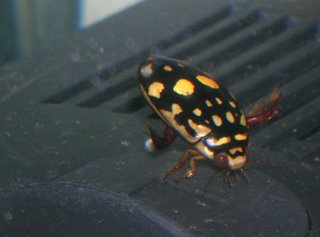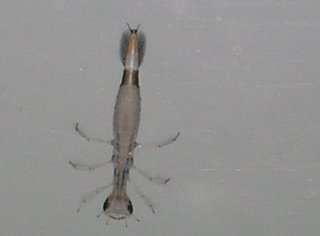Sunburst Diving Beetles

The aquatic beetle investigates the bottom of the aquarium, nosing into the gravel in search of prey. Needing oxygen, it pivots and, looking like a tiny submersible vessel, swims to the top of the tank for air before resuming the hunt. Off and on over the past several years we have maintained a tank of sunburst diving beetles at the Museum. Their bizarre yet cute appearance (they are just 1/2" long) and interesting behavior make them one of our more popular live animal displays.
Our sunburst diving beetles come from Arizona, and the current crop was obtained during my recent trip to the Sonoran Desert. Although we like to keep a display of them, we have done so only intermittently because they are expensive. Fortunately, it’s not at all uncommon for them to live for over 6 months in captivity. Still it had been nearly a year since we have displayed any, so the collecting trip was a welcome opportunity to turn things around.

Sunbursts, sometimes called spotted diving beetles, live in the southwestern part of the country and range south into Mexico. They seem to prefer slightly less arid mountainous habitats rather than the desert lowlands. Still they are from a hot, dry region and their scientific name, Thermonectus marmoratus, reflects this. Thermonectus means "warm swimmer." We caught several in the pools that you see in the picture here, and several more in Sycamore Canyon. We managed to return to Chicago with four of them.
In an attempt to overcome the problems we have encountered previously with irregular availability of the beetles, we did not place this group on public display. Instead, we set up a tank to try to breed them in. It’s a normal aquarium with a floating platform that has damp peat moss on it. Sunbursts crawl out of the water to lay their eggs on damp soil.

Three weeks ago our efforts were rewarded and we found hatchlings in the tank. Beetles, like butterflies, undergo complete metamorphosis; that is, they pass through egg larva and pupa stages before becoming adults. The larvae look nothing like the adults. Diving beetle larvae are called water tigers. We are feeding ours frozen bloodworms. Unfortunately, they will also eat each other given the opportunity, so we have set each water tiger up in its own cup.

Water Tiger
Eventually, the water tigers will leave the water to pupate in damp soil. We’re using peat moss, although none of the beetles has yet reached pupation stage. We have gotten several dozen larvae so far, and they seem fairly easy to raise. With luck, we will soon have a vibrant display of dozens of sunburst diving beetles.

Rearing Water Tigers


9 Comments:
That sounds so exciting! I loke to do smaller projects with the kids like that. Our last project was the Tomato worm and all went fine till the end. Our book said he would come out in spring but in fact he came out about two weeks later and I didn't know it and he died ;( The little thing took one for the team I guess. Keep us posted on what happens next I'll be curious to see!
I like to do.....I really should proofread.
Doug
your blog is really doing well!
I love learning (or is it relearning?) some bug basics and science 101.
Keep these coming.
Cool! As a northeasterner, I don't see nor am I familiar with many of the creatures (or landscapes) that you show here. I'm enjoying (and learning from) each of you posts. Thanks!
Another gret post. I'm just curious why it's so expensive to keep the Sunbursts?
It's not expensive to keep them, it's expesnive to buy them. They cost $7 each, plus shipping. You need a bunch to make a good display. We went through a period a couple of years ago where we were having trouble with them. They would die after just a few weeks. Our burn rate was about $1000 annually to keep the tank well-stocked, and I couldn't justify that.
P.S. One of the reasons that they are so expensive to buy is that there are few suppliers. The suppliers that I am aware of do not breed their own. They obtain their stock of this and many other invertebrates by going out into the wild and collecting them. This is all pretty labor intensive. There can also be unpleasant aspects to the process of collecting invertebrates. We have had some very interesting experiences collecting ants. Hmm...that would probably make a good topic for a future posting.
$7 for a bug? You have to be kidding me Doug. To each his own...to each his own. And I thought mother nature was essentially free. Have a good weekend! Nice post.
Did ever get them to pupate? We are trying to propagate as well and we can get them to 2nd or 3rd instar and then they die. Trying to figure out what we are doing wrong!
Post a Comment
<< Home